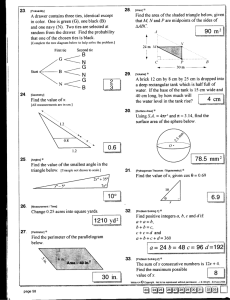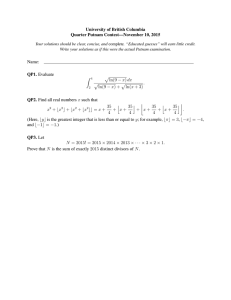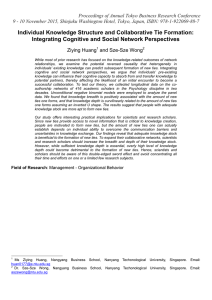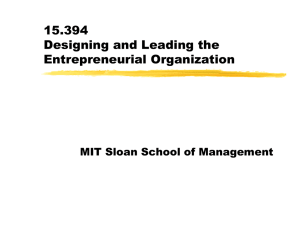Civil Society and the Dangers of Social Capital (Rewrite) Christopher Suarez
advertisement
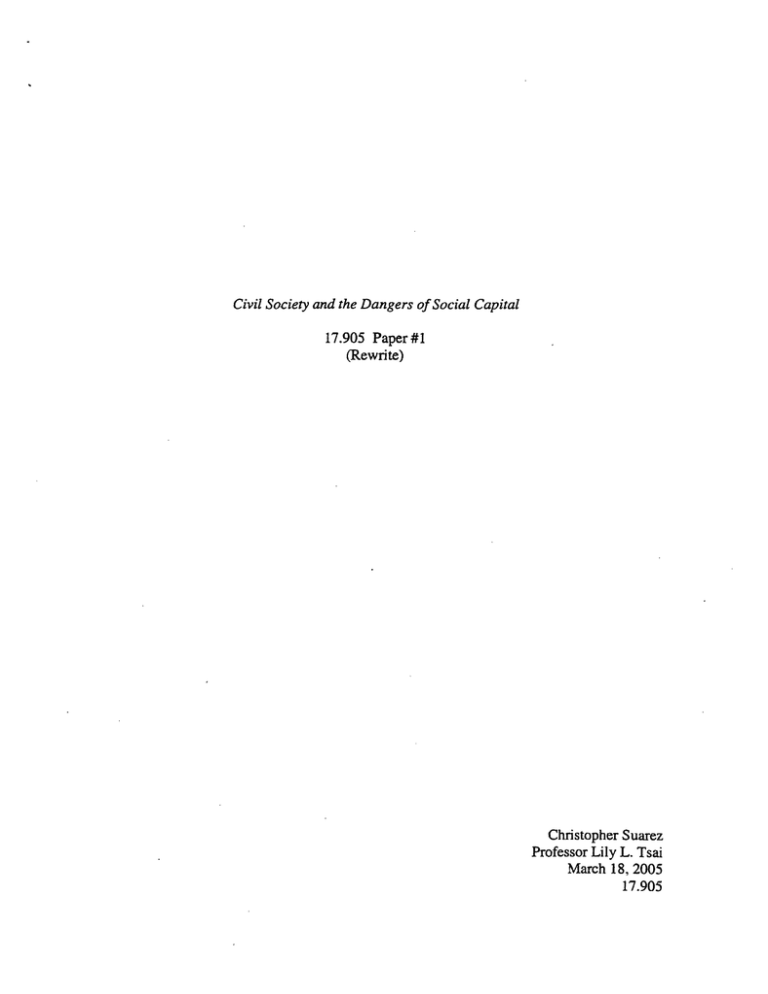
Civil Society and the Dangersof Social Capital 17.905 Paper #1 (Rewrite) Christopher Suarez Professor Lily L. Tsai March 18, 2005 17.905 Suarez Civil Society and the Dangersof Social Capital Social capital is a very useful concept. In fact, it may be too useful. In this paper, I argue that it is dangerous to apply the concept of social capital to theories of civil society. Despite its potential utility, current social capital theory is underdeveloped and is often misapplied to civil society, sometimes to the point of being completely unnecessary. Social capital theories have already been applied too widely and, arguably, this has triVialized the concept. Moreover, in justifying civil society theories using social capital, theorists are less able to focus on exogenous factors that contribute to civil society - historical context, culture, and economics - that seem to play as strong of roles as any in shaping outcomes of civil society. Finally, the quantifiable aspects of social capital are not rqbzsdy developed at this time, and scholars mislead both themselves and the public in drawing conclusions from quantified social capital. This essay will go into detail in each of these topic areas and elucidate the key points relevant to each discussion. Before describing these dangers, however, it is first important to establish a working definition of civil society. For our purposes, civil society represents self-generating, selfsupporting, state independent organizations that allow citizens to act collectively in the public sphere to express their interests. Good or bad, civil society represents a mechanism through which the societal will can prevail publicly, be it through government policy or the establishment of cultural customs. Civil society represents the bridge that separates private and public spheres, and is a necessary intermediary between the two. Social capital, on the other hand, plays a more microscopic role. Patrick Kilby, in describing the relationship between civil society and social capital, explains that, while civil society represents non-governmental institutional arrangements of society in governance, social capital describes the underlying social relationships from which these institutional arrangements 'Diamond, Larry. "Toward Democratic Consolidation." p. 228 1 Suarez emerge. This description implies the difference in scale between the two concepts. Civil society is a group concept used to affect change at the level of a large community. It is used in maintaining social norms within a town, lobbying a national legislature to decrease taxes, or in proposing a worldwide summit to promote women's rights. As such, civil society operates at a macroscopic level. This is unlike social capital, which can operate both microscopically and macroscopically. With every relationship, bond of trust, obligation, or expectation, a marginal unit of social capital is added. Further, social capital can be generated in public and in private. Just as it is generated on Capitol Hill as people lobby to pass a bill, it is generated in families as children form bonds of trust with their mothers.2 With good reason, political scientists have increasingly used the concept of social capital to justify their respective formulations of civil society. 9 rclvil society and social capital, social capital is certainly more useful. Since it operates as a micro-level concept, social capital helps explain how relationships and ties between individuals and groups can lead tdesired (or possibly undesired) outcomes in almost any situation. Moreover, social capital is both tangible and quantifiable, allowing scholars to use it in rationalizing the legitimacy of theories of civil society. While past theories of civil society were based on mere intuition, theories of civil society could now be "grounded" in social capital. With social capital, a theory of associations no longer assumes only that associations inherently lead to change. Rather, the theory can posit that associations generate social capital, economic transfers are made, and change is produced from those transfers. Social capital would seem valuable to any discussion of civil society. However, recent definitions of social capital have opened up the concept to overly broad interpretations. James Coleman wrote in Social Capital in the Creation of Human Capital that 2 Kilby, Patrick. "Social Capital and Civil Society." National Center for Development Statistics 2 Ju. ,IL. social capital can take many forms: obligations, expectations, trust, information, or norms. Social capital is also "fungible," and forms of social capital that may be useful for one end may be "useless or even harmful for others." To him, social capital resides within relations between individuals and groups.3 Putnam, finally, argued in Making Democracy Work that social capital could also reside within individuals, making an already ambiguous definition of social capital even more applicable.4 As such, more and more applications of social capital have been observed. In his paper on social capital in community development, James DeFilipis provides two examples; the name of a 1999 Urban Affairs Convention ("The Social Construction of the City: Social Capital and Community Building") and the incorporation of social capital discourse within funding initiatives for community building. s5 Today, a simple search on Google will yield information from the Canadian government referencing several studies on how your individual social capital determines your personal health.6 More abound. / Alejandro Portes explains that social capital has essentially developed into an elixir that scholars use to solve all of the problems of the world. At te point it has been applied within so I many contexts, it begins to lose some of the meaning it may have once had.7 This does present some danger, as social capital may eventually be discredited to such a degree that it gets lost in the shuffle, never to be considered again when it may have had some future value in explaining phenomena. Its broad misapplication today could undermine its narrower, more proper application tomorrow. 3 Coleman, James. Social Capital in the Creation of Human Capital Putnam, Robert. Making Democracy Work 5 The Myth of Social Capital in Community Development, James DeFilipis, Housing Policy Debate, Fannie Mae Foundation, 2001 6 "Social Capital as a Health Determinant: How is it Defined?" http:l/www.hc-sc.gc.caliacb-dgiac/arad-draa/english/rmdd/wpaperslengsocial2.html 4 7 Portes p. 2 3 Suarez Part of the reason that social capital is so broadly applied is due to the normative instincts of social scientists. Civil society itself is a very normative concept, and, in general, social scientists like to discuss it in terms of the good that can arise from it. Most discussions of civil society center on the overthrow of authoritarian regimes or the successful implementation of social change. Social capital, as a more powerful and seemingly positive concept, allows social scientists to naively fulfill their desires to make normative claims. Out of this desire, some applications of social capital to civil society have become tautological. The prime example of this is in Making Democracy Work, where social capital is simultaneously represented as a cause and an effect. The book argues that high levels of social capital produce positive outcomes, such as high government performance. Meanwhile, it infers these high levels of social capital by examining the government characteristics of successful and unsuccessful cities. This practice is not necessarily bad. However, in desiring to make the normative (and more appealing) claim of a relation between social capital ano government performance, Putnam limited his social capital descriptors to civic factors, knowing that these factors were generally correlated with the cities whose governments performed better. Putnam essentially said that civic minded cities do civic things well.8 Many discussions of social capital can be done without. And this is not only the case with Putnam's tautology. When Jean-Pierre Worms discusses social capital in France, for example, he discusses a missing link syndrome in which large associations, directly connected to the state, become isolated from is d and therefore. He thus presents a solution in which several institutional reforms could be made to reestablish flows of social capital. By linking the state to its citizens, he argues that civil society will be revitalized. Again, in a tautological form, Worms says that a government in which citizens voices are not heard can be remedied by a s Portes p. 19-20 uarez government in which citizens voices are heard. But isn't that obvious? We could have inferred this without any discussion of social capital, and could have instead focused on the mechanisms through which a robust civil society may have been established in France.9 As scholars become preoccupied with their large stockpiles of social capital, they also glaze over political and economic changes that may have been confounding factors in shaping social conflicts. Regarding Putnam, John Ehrenberg points out that "[Putnam's] focus on 'social capital' signals [his] relative lack of interest in the political and economic roots of civic decline, something he shares with the moralizing neo-Tocquevillean theories of civil society" (230). Ehrenberg further explains how many civic organizations were created from state stimuli and not a sense of civic virtue. He also cites Skocpol, who argues that many associations grew out of political and economic changes such as World War II and the New Deal.' More specifically, preoccupations with stores of social capital ignore the role of economic restructuring in shaping civil society and public perception. " This Asrelevant in Poland, Russia, some African and Arab states, China, or in any other state that may move toward privatization and away from economic systems in the spiri~of authoritarian or communist rule (or vice versa). It is clear that the privatized economy of Lebanon, in addition to Lebanon's history of communal ties, influences its standing as one of the more "democratic" states of the Arab world.'2 It is also clear that, despite the long history of Polish "solidarity" and protest, its .ivil society became stronger as citizens gained confidence in a collective ability to affect change pos-democratization. Social capital alone does not explain the ebbs and flows'of civil societies. Jean-Pierre. "Old and New Civic Ties in France." Democracies in Flux. Oxford, 2002. p. 186-188. '0Ehrenberg, John. Civil Society: The Critical History of an Idea. New York: New York University Press, 1999. " Edwards, Bob and Foley, Michael. "Escape from Politics? Social Theory and the Social Capital Debate." 9 Worms, 12 American Behavioral Scientist, 1997. 40:5:551. Harik, Iliya. "Pluralism in the Arab World." 5 Suarez Additional errors in social capital theorizing are encouraged by social capital's perception as a quantitative measure instead of a qualitative description. Pierre Bourdieu set the stage when he defined the concept as "the aggregate of the actual or potential resources which are linked to possession of a durable network of more or less institutionalized relationship...." Fukuyama attempts to take this notion of quantification further by summing the memberships of groups and adding cohesion, radius of trust, and radius of distrust coefficients. 13Generally, we encourage quantitative measures as objective measures of things. However, in this case, we are dealing with something that is incredibly difficult to quantify. How, for example, do we sum small networks of trust with large networks of trust? Are they at the same level of social capital? What about negative social capital? Social capital's visualization as a quantitative concept invites false overestimates of its power. And indeed, numerical measures of social capital can be sufficiently gerrymandered to achieve a given end. Our whipping boy, Making Democracy Work, had this pr6 blem when it lumped various factors of civic virtue into a single composite measure. This fact, along with the single-factor weighting of performance indicators performed by Putnam, makes an otherwise weak finding appear more robust.'4 James Gibson's discussion of social capital in Russian civil society also attempts to draw substantive conclusions from weak data. In his study, Gibson uniformly assumes that all within-family ties are strong while all of those made outside of the family are weak. Although this may possibly describe the majority of strong and weak ties, this is a very coarse measure. Gibson's conclusion that Russian social networks are strong because 3 Fukuyama, Francis. "Social Capital and Civil Society." Presented at the IMF Conference on Second Generation Reforms, October 1, 1999. http://www.imf.orolexternal/pubs/ft/seminar/1999/reformslfukuvama.htm Robert W., and Ross A. Miller. "A Renaissance of Political Culture?" American Journal of Political 14 Jackman, Science. 1996. 40:3:632-659, p. 639 6 . Ar.ez they contain many weak ties is undermined bvytheform of this measure. ' How do we know that the ties he identified as weak were actually weak? Were these ties necessarily good things? Luckily, there are members of the social capital school who are able to place the theory in its proper place. For example, when Mark Granovetter makes a compelling argument about the gains to be had from weak social ties. he discusses the positive results that could be achieved from these ties. Nevertheless, he also admits there could be negative ties - a strained friendship, a begrudged former colleague - that may be detrimental to the attainment of these results. He also admits that the strength of ties is very difficult to measure, and that purely focusing on their strength ignores "all important issues involving their content." Because the concept of social capital is so intertwined with interpersonal associations, his discussion is very relevant. Just as it is hard to measure the strength of ties, it is difficult to measure quantities of social capital. " Ultimately, the words of sociologists are key. Granovetter reminds us that sociology is sociology, and that political science is political science. Sociologists definitely do need to investigate the strength of ties and the impact of associations, and political scientists need to understand these things. However, political scientists alsopeed to understand how institutions operate infull. As a continuing factor in this debate; social capital has attempted to simplify an incredibly complex concept of civil society into an immeasurable quantity, and has enticed many political scientists to remain on a one-track mind towards potentially false conclusions. Therefore, discussions of social capital need to be divorced from civil society nnAthi qhnmll remain the case until theories of social capital are further refined. In the interest of maintaining a direct, accurate focus on all the factors that may contribute to civil societies, this is worth it. 15 Gibson, James L. "Social Networks, Civil Society, and the Prospects for Consolidating Russia's Democratic Transition." American Journal of Political Science, 45:1:51-68, p. 59 and 65 16 Granovetter, Mark S. 'The Strength of Weak Ties." The American Journal of Sociology. 78:6:1360-1380. 7 Suarez Works Cited "Social Capital as a Health Determinant: How is it Defined?" http://www.hc-sc.gc.ca/iacb-dgiac/arad-draa/english/rmddlwpapers/engsocial2.html Coleman, James S. "Social Capital in the Creation of Human Capital." The American Journal of Sociology. Vol. 94 Supplement: 1988:S95-S 120. Defilipis, James. The Myth of Social Capital in Community Development. Housing Policy Debate, Fannie Mae Foundation, 2001. Diamond, Larry. "Toward Democratic Consolidation." in The Global Resurgence of Democracy, ed. Larry Diamond and Marc Plattner, 1996, pp. 227-240. Edwards, Bob and Foley, Michael. "Escape from Politics? Social Theory and the Social Capital Debate." American Behavioral Scientist, 1997. 40:5:550-61. Ehrenberg, John. Civil Society: The Critical History of an Idea. New York: New York University Press, 1999. Fukuyama, Francis. "Social Capital and Civil Society." Presented at the IMF Conference on Second Generation Reforms, October 1, 1999. Gibson, James L. "Social Networks, Civil Society, and the Prospects for Consolidating Russia's Democratic Transition." American Journal of Political Science, 45:1:51-68 Granovetter, Mark S. "The Strength of Weak Ties." The American Journal of Sociology. 78:6:1360-1380. http://www.imf.org/extemal/pubs/ftlseminar/1999/refolms/fukuvama.htm Harik, Iliya. "Pluralism in the Arab World." The Global Resurgence of Democracy, ed. Diamond and Plattner, 1996, Chapter 23. 8 Suarez Jackman, Robert W., and Ross A. Miller. "A Renaissance of Political Culture?" American Journal of Political Science. 1996. 40:3:632-659, p. 639 Kilby, Patrick. "Social Capital and Civil Society." National Centerfor Development Statistics Portes, Alejandro. "Social Capital: Its Origins and Applications in Modem Sociology." The Annual Review of Sociology. 1998. 24:1-24. Putnam, Robert. Making Democracy Work Princeton, 1993. Seligman, Adam B. The Idea of Civil Society. New York: The Free Press, 1992. Worms, Jean-Pierre. "Old and New Civic Ties in France." Democracies in Flux. Oxford, 2002. p. 186-188. 9
